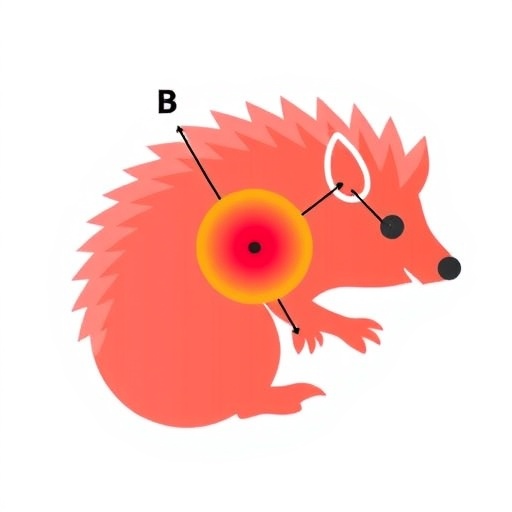In the relentless pursuit of understanding glioblastoma multiforme (GBM), one of the deadliest and most aggressive primary brain cancers, researchers have identified a novel molecular player that could revolutionize prognosis and treatment strategies. The protein NFKB inhibitor epsilon (NFKBIE) emerges as a critical determinant in GBM progression, offering new avenues for targeted therapy against this formidable disease.
Glioblastoma’s notorious resistance to conventional treatments and rapid progression underscore the urgent need for innovative biomarkers that can stratify patient prognosis and guide therapeutic interventions. Recent comprehensive bioinformatics analyses have spotlighted NFKBIE, revealing its elevated expression in GBM tissues relative to normal brain and other cancer types. This overexpression correlates with notably poorer clinical outcomes, including diminished overall survival and disease-specific survival.
The significance of NFKBIE extends beyond mere expression levels. Through interrogation of genomic datasets, researchers have discerned that genetic alterations in the NFKBIE gene, such as copy number variations and elevated tumor mutational burden, closely align with tumor aggressiveness and progression. This suggests that NFKBIE is not just a passive marker but might have a functional role in driving tumor biology.
Delving into experimental research, scientists employed small interfering RNA (siRNA) technology to suppress NFKBIE in established GBM cell lines, notably U87 and T98G. These cell culture models served as critical platforms to dissect the functional consequences of NFKBIE downregulation. The results were compelling — silencing NFKBIE induced a significant reduction in GBM cell proliferation as demonstrated by assays like Cell Counting Kit-8 (CCK-8) and clonogenic survival.
Beyond the ability to proliferate, GBM cells are notorious for their invasive and migratory prowess, contributing to poor surgical outcomes and relentless recurrence. The inhibition of NFKBIE markedly curtailed these malignant traits, as validated in wound healing and Transwell migration assays. Cells with diminished NFKBIE lost much of their capacity to invade surrounding tissue or migrate, indicating that NFKBIE is instrumental in maintaining the aggressive phenotype of GBM.
Cell death through apoptosis represents a key therapeutic approach in cancer treatment. Interestingly, the suppression of NFKBIE triggered an increase in apoptotic cell populations, as detected by TUNEL staining in vitro. This pro-apoptotic effect mimics desired treatment responses and further positions NFKBIE as an attractive therapeutic target—its inhibition both halts tumor growth and promotes tumor cell death.
At the molecular level, Western blot analyses revealed that knockdown of NFKBIE altered the expression of pivotal proteins associated with cancer hallmarks. Markers linked to cell proliferation, stem cell-like properties, migration, invasion, and apoptosis underwent significant modulation, reflecting the multifaceted influence of NFKBIE on GBM cellular behavior.
Translation of these findings into in vivo models strengthened the therapeutic promise. In mouse xenograft systems, where human GBM cells were implanted and allowed to form tumors, silencing NFKBIE led to a pronounced deceleration of tumor growth kinetics. Histopathological examination of excised tumors confirmed reduced cellularity and diminished malignant features in NFKBIE-depleted tumors, aligning with the in vitro data.
Perhaps the most intriguing discovery lies in the mechanistic link between NFKBIE and the Hedgehog signaling pathway—a critical regulator of development and oncogenesis. Reduction in NFKBIE expression curtailed key components of the Hedgehog cascade, suggesting that NFKBIE exerts its pro-tumorigenic effects partly by modulating this pathway. Given Hedgehog’s established role in tumor cell proliferation and stemness, this interface highlights a novel axis ripe for therapeutic exploitation.
The intersection of these discoveries paints a compelling narrative: NFKBIE acts not only as a prognostic biomarker, indicative of disease severity and patient outcomes, but also as a driver of malignant progression through the Hedgehog signaling activation. Targeting NFKBIE could, therefore, disrupt vital oncogenic circuits and cripple the tumor’s ability to grow and evade cell death.
This research opens a promising new chapter in GBM treatment paradigms. Whereas current therapies often falter against the tumor’s complexity and heterogeneity, molecular intervention at the level of NFKBIE offers a dual benefit—improving prognostic assessments and providing a novel therapeutic target. Such an approach could potentially synergize with existing treatment modalities, paving the way for more effective combinatorial regimens.
It is essential to contextualize these findings within the broader landscape of cancer biology. The nuclear factor kappa-light-chain-enhancer of activated B cells (NF-κB) family, to which NFKBIE is related, has long been recognized for its role in inflammation, immunity, and cancer. The elucidation of NFKBIE’s specific contribution to GBM pathophysiology surfaces as a critical refinement enhancing our understanding of NF-κB family members’ involvement in tumorigenesis.
Future clinical translation will require rigorous evaluation of NFKBIE-targeting agents’ safety and efficacy in more complex in vivo models, and ultimately, human trials. Understanding potential resistance mechanisms and identifying patient subgroups who would benefit most are key next steps. Moreover, the interplay between NFKBIE and Hedgehog signaling invites exploration of combination therapies targeting both axes to maximize therapeutic efficacy.
In summary, the identification of NFKBIE as a robust prognostic biomarker and therapeutic target offers renewed hope in the fight against glioblastoma. This breakthrough is a testament to the power of integrated bioinformatics and experimental strategies, uncovering molecular vulnerabilities that can be leveraged against even the most recalcitrant tumors.
Subject of Research: Glioblastoma multiforme (GBM); molecular biomarkers; NFKB inhibitor epsilon (NFKBIE); Hedgehog signaling pathway
Article Title: NFKBIE as a prognostic biomarker and therapeutic target for GBM: role in Hedgehog signaling activation
Article References:
Mo, F., Li, Y., Dong, C. et al. NFKBIE as a prognostic biomarker and therapeutic target for GBM: role in Hedgehog signaling activation. BMC Cancer 25, 1512 (2025). https://doi.org/10.1186/s12885-025-14775-9
Image Credits: Scienmag.com
DOI: https://doi.org/10.1186/s12885-025-14775-9
Tags: bioinformatics in cancer researchbiomarkers for GBM prognosisclinical outcomes related to NFKBIEelevated NFKBIE expression in GBMgenetic alterations in NFKBIENFKBIE in glioblastoma multiformenovel treatment strategies for glioblastomaresistance to conventional GBM treatmentsrole of NFKBIE in tumor progressionsiRNA technology in cancer researchtargeted therapy for brain cancertumor mutational burden in GBM





